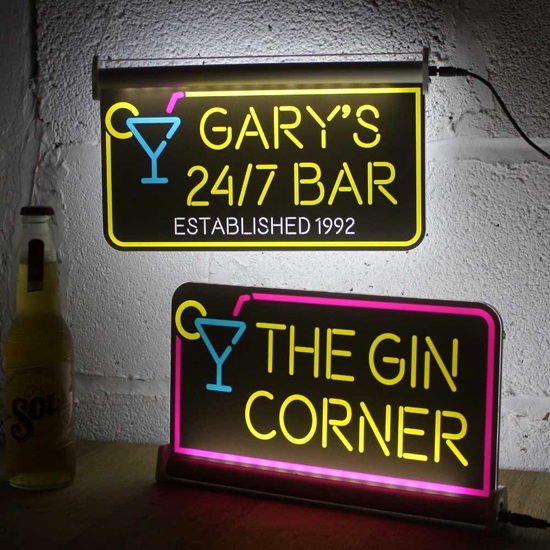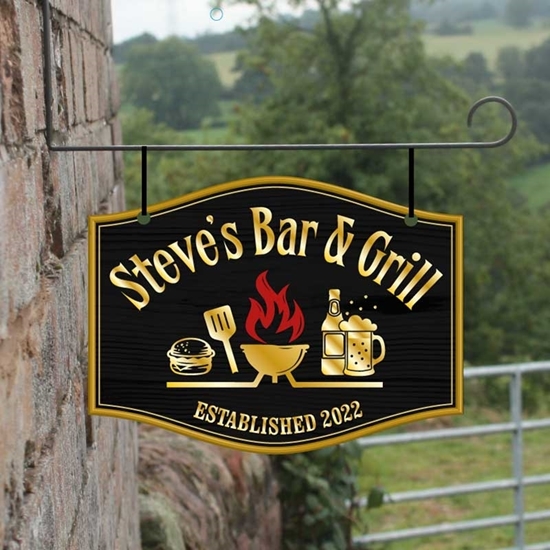Recommended Advice To Deciding On Personalised Pub Signs
Wiki Article
What Are The Differences Between Bar Signs In Terms Style And Design?
The design and style of bar signs varies based on the ambiance, intended audience, and the theme of the location. Here are a few examples of most popular designs and styles: 1. Vintage/Retro
Characteristics include a nostalgic, classic style, often weathered or distressed.
Utilization of old fonts, images, old wood, metal, and old-school logos.
Uses : Ideal for restaurants and bars that have a nostalgia like speakeasies and pubs.
2. Modern
Characteristics: Sleek, clean, minimalist.
Design Elements: Simple fonts, bright or monochromatic color schemes, geometric shapes, and are often made of materials such as acrylic or metal.
Uses: Ideal for modern bars, trendy cocktail bars and upscale lounges.
3. Rustic
Characteristics: Natural and earthy.
Design elements Utilization of reclaimed wood, hand-painted or carved lettering, natural colors, and rustic finishes.
Uses: Ideal for country-style pubs, farm-to-table establishments, as well as mountain lodges.
4. Industrial
Characteristics: Raw, unfinished, edgy.
Design Elements: Exposed Metal pipes, reclaimed materials neutral tones, and bold fonts.
Applications: Ideal for bars in urban and warehouse settings.
5. Glamorous
Characteristics: Elegant, luxurious, eye-catching.
Design elements: use of metallics, gold (silver and so on. ), glitter, elaborate typography, and elegant graphic.
Uses: Great for high-end nightclubs, bars, and other establishments with a high-end customer base.
6. Nautical
Characteristics: Coastal and marine.
Design Elements: Nautical symbols like ships and anchors, blue and white colors, ropes and wood texture.
Uses : Beach bars, seafood restaurants, and waterfront establishments are great for this product.
7. Tropical
Characteristics: Bright, colorful, relaxed.
Design elements: vibrant colors, palms, tropical flowers and playful fonts. Beach images.
Uses: Great for the beach, tiki bars and other establishments with a theme of islands.
8. Sport
Characteristics: Energetic, team-oriented, spirited.
Design elements Logos of teams sporting imagery, bold colors and dynamic fonts.
Perfect for pubs, sports bars, and fan zones that cater to fans of sports.
9. Steampunk
Characteristics: Futuristic, Victorian, mechanical.
Design elements: cogs, gears and pipes and brass textures, antique fonts.
Great for themed bars which blend traditional elements with futuristic ones.
10. Art Deco
Characteristics: Glamorous, geometric, bold.
Design Elements Geometric patterns and dark and gold colors. symmetrical design, elegant fonts.
Uses: Great for bars that want to evoke the 1920s Gatsby-style of elegance.
11. Humorous/Quirky
Characteristics: Fun, light-hearted, engaging.
Design Elements. Fun fonts. Funny slogans. Graphics with cartoonish characters.
Uses: Great for casual bars, dive bars and places that want to create a fun and relaxed environment.
12. Traditional Pub
Characteristics: Warm, inviting, classic.
Design elements include dark wood traditional fonts, heraldic symbols.
Uses The product is an excellent product for British and Irish pubs as well as establishments with an old-world European feel.
13. Western
Characteristics: Rustic, rugged, cowboy-themed.
Design elements: Wooden textures, cowboy imagery rope fonts, earthy tones.
Uses: This product is suitable for western themed bars, BBQ restaurants, and music venues that are country in nature.
14. Neon
The characteristics are bright colors, vivid and eye-catching.
Design Elements : Neon light with a variety of colors, and sometimes simple graphics and fonts.
Uses: Ideal for modern bars and nightclubs that are looking to have a fun, energetic vibe.
15. Minimalist
Characteristics: Simple, clean, understated.
Design elements : Use of monochromatic color schemes, or minimalist fonts in monochrome.
Uses: This is the perfect option for modern, stylish bars looking for a sleek and classy style.
If they choose the best design the bar's owners can achieve a consistent look and feel that improves customers' experience as well as the overall atmosphere. See the recommended click this link on bar hanging sign for website tips including pub wall sign, hanging pub signs for garden, hanging pub signs for garden, pub signs for garden bar, the staying inn sign, personalised metal pub signs, pub signs, cocktail bar sign, signs for the bar, make a bar sign and more.

What Are The Differences Between Bar Signs In Regards To Mounting And Setting Up?
The installation and mounting of bar signs depends on the kind of sign, its weight, dimension, location and use. This article will give details on the various mounting and placement alternatives for bar signs. Wall-Mounted Signs
Directly fixed to walls.
Methods:
Screws and anchors Anchors and screws: This is typical for larger signs like metal or wood.
Adhesive strip: for installation that is temporary or light in nature and signs (foamboard and acrylic).
Brackets that are used to hold signs hanging off the walls to provide more visibility.
Uses: Indoor decor, menu boards, directional signs.
Advantages: Secure, flexible and allows for a prominent display.
Disadvantages: Can cause damage to walls, and are difficult to reposition.
2. Hanging Signs
Specifications Suspended ceilings or overhangs.
Methods:
Chains: Durable and adjustable suitable for signs with heavy weights.
Cables: Contemporary designs typically make use of cables to give them a sleeker appearance.
Rods: Provide a rigid support structure.
Uses: Ceiling decor, directional signs, overhead promotional signs.
Benefits: Increased visibility Uses vertical space and can be decorative.
Disadvantages
3. Freestanding Signs
Specifications: Does not connect to any other structure. Supported by a base or stand.
Methods:
A-Frames : foldable and portable. Often employed for advertising on sidewalks.
Pedestal Stands: Stable base, ideal for indoor use.
Post and panel: Common for larger permanent signs.
Uses: Outdoor advertising, indoor directional signs, promotional displays.
Flexible, portable and able to be easily relocated.
The downside is that it can be heavy. It also requires lots of area for floor.
4. Window Signs
The characteristics of the windows are directly attached to them.
Methods:
Suction cups: Easy installation and removal, suitable for smaller signs.
Adhesive Vinyl can be used to create decals or graphics.
Static Cling: Permanent, non-permanent and simple to remove or apply.
Uses: Marketing advertising, branding and operating hours.
The window is highly visible and maximizes the amount of space available.
Limitations: Can be affected by sunlight, limited by the dimensions of the window.
5. Backlit and Edge-Lit Signs
Features: Add lighting to the sign structure.
Methods:
Wall Mounting with Electrical Connections. This requires electrical connections and secured attachment.
Suspended by Power Cables Combining hanging methods with integrated lighting.
Utilizes: Branding with high-visibility, menu boards as well as decorative elements.
Benefits: Increase the visibility of your home, and provide attractive lighting.
Negatives
6. Temporary Signs and portable Signs
Created with simple installation and removal in mind.
Methods:
Pop-up Stands: Lightweight and compact.
Banner Stands: Roll-up or retractable designs.
Uses include: celebrations, events or seasonal decorations.
Benefits: Fast and simple setup, transportable.
Negatives
7. Magnetic Signs
The force of magnetic forces is utilized to fix the magnet.
Methods:
Magnet Strips: Adhere to the back side of the sign.
Magnetic Boards: Signs which attach to metal surfaces.
Uses: Changeable menu boards Temporary notices.
Benefits: No permanent fixtures are needed, and the product is easy to replace.
Advantages: Restricted to surfaces with magnetic properties, they are less secure.
8. Projection Signs
Specifications: Light is used to show images and text.
Methods:
Mounted Projectors - Securely attached to walls or ceilings.
Portable Projectors can be set on stands or other surfaces.
Uses: Events, promotions Dynamic displays.
Benefits The content can be modified easily and no physical signage is required.
Negatives: requires a controlled lighting system and is dependent on the projector's quality.
Considerations for Mounting and Installation
Size and weight
Heavy Signs: Need more robust mounting solutions like screws and anchors.
Light Signs are made using simpler methods, like suction cups or adhesive strips.
Durability
Permanent Signs: Use mounting techniques that are more sturdy and safe.
Temporary Signs: Choose methods that make it easy to remove and repositioning.
Location
Indoor: Less concern with weather resistance, more adaptability of the materials and techniques.
Outdoor: The material used to mount outdoor items should be weatherproof and should be mounted with a solid structure.
Aesthetics
Concealed Mounting - Gives a neat look by hiding the hardware for mounting.
Signs can be accentuated by adding decorative hardware.
Accessibility
Simple access to changes: This is important for menu boards, signs and other signage which require regular updates.
Security: Signs are guarded from being easily altered or taken.
Consider these factors when choosing the best mounting and installation methods to install your bar. You can be assured that the bar's design is in line with both functional and aesthetic requirements. Follow the most popular gin bar sign examples for blog recommendations including personalised signs for home bar, large bar signs, bar signs, signs for garden bar, personalised pub signs for sale, personalised signs for bar, pub signs, pub bar signs for sale, personalised hanging bar sign, personalised pub and more.

How Do Bar Signs Differ In Terms Of Regulations?
Bar signs are subject to a myriad of rules imposed by local, state, and federal authorities to ensure safety for the public as well as aesthetic standards, and the compliance with the zoning laws. These are the main differences between bar signs and their rules. Dimensions and placement regulations
Zoning laws: These regulations determine where signs may be placed, their size, distance, and height and height, as well as the distance between them and property lines, roadways, or other buildings.
Historical Districts - Signs can be limited in dimensions, style, and materials to protect the historical characteristics of certain areas.
2. Illumination Restrictions
Light Pollution Regulations Limit the brightness, color and length of illuminated signage to minimize light pollution and preserve the ambience of night.
Safety: Signs must not cause glare, or distracting light that could pose dangers to drivers and pedestrians. This is especially important near roads.
3. Signage Content
Alcohol Advertising: Alcohol advertisements are restricted in certain jurisdictions. They are prohibited from using images or content which may be appealing to minors or encourage excessive drinking.
Health Warns: Certain laws could require that signs include warnings about the risks of drinking alcohol or smoking.
4. Historic Preservation Regulations
Signs that are placed in historical districts must be in harmony with the architectural style of the district. This is typically accomplished by preservation boards and commissions.
Materials and Design. Sign materials are subject to restrictions and design, as well as color schemes can be imposed to preserve the historic integrity.
5. Sign Permitting Process
Permits are needed: Owners of bars must get permits to put up or alter signage. This can include submitting drawings, paying fees, as well getting approval from local authorities.
Code Compliance: To ensure accessibility and security for the public Signs must be in compliance with the building codes, safety regulations and accessibility standards.
6. Sign Removal, Maintenance and Repair
Maintenance Requirements Owners of bars are responsible to keep their signs in good order, making sure they're structurally sound, free of hazards, and comply with the regulations.
Abandoned Signs: Regulations may regulate the removal of signs that are abandoned or damaged to avoid blight while conserving the aesthetics of the surrounding area.
7. Digital Signage Regulations
Content Restrictions. There could be laws that restrict the types of content that is displayed on digital signs. These laws could restrict flashing lights or offensive imagery.
Digital Signage Operational Limits - Regulations may limit the brightness or motion as well as frequency of changes for digital signs in order to minimize the visual clutter as well as distracting distractions.
8. Enforcement and Penalties
Inspections Local authorities conduct periodic inspections to ensure the compliance of sign regulations. There are citations issued for infractions.
Penalties: Penalties may include fines or court orders, requests for signs to be taken down or modified, and legal action.
9. Sign Variance Process
Variance applications: Bar owners who wish to alter their signage in accordance with the rules can do it by applying for the variance. The reason for the variance must be given as well as any negative effects on the public's security or appearance must be considered.
Public Participation. Variances could need public hearings or participation from members of the community. This may include property owners nearby businesses, residents, or members of neighboring communities.
10. Community Input, Engagement and Engagement
Public Consultation - Some jurisdictions include community members in the design and the implementation of signage regulations through organizing public meetings or surveys.
Community Benefits : Sign Regulations could contain provisions to help promote local businesses, or to revitalize the neighborhood.
Bar owners who understand and follow signage regulations can make sure that their signs attract patrons, thereby benefitting their local community, and complying with legal standards. This reduces the possibility of legal disputes, fines or penalties. Follow the best hanging pub signs for blog examples including bar signs for garden, personalised cocktail sign, make a bar sign, hanging pub signs, personalised signs for bar, hanging pub signs for garden, hanging tavern sign, garden bar sign personalised, modern pub sign, home bar pub signs and more.
